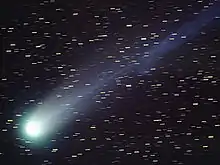75D/Kohoutek
75D/Kohoutek is a short-period comet discovered in February 1975, by Luboš Kohoutek. Even on the discovery plate the comet was only apparent magnitude 14.[1] Assuming the comet has not disintegrated the 2020-2021 perihelion passage is only expected to peak around apparent magnitude 20.
| Discovery | |
|---|---|
| Discovered by | Luboš Kohoutek, Hamburg-Bergedorf Observatory |
| Discovery date | February 1975 |
| Orbital characteristics | |
| Epoch | 2014-07-02 (JD 2456840.5) |
| Aphelion | 5.3 AU |
| Perihelion | 1.8 AU |
| Semi-major axis | 3.5 AU |
| Orbital period | ~7 years |
| Inclination | 5.9° |
| Last perihelion | July 2014(?) (last seen 1988) |
| Next perihelion | Lost (March 2021?) |
Not to be confused with the much better-known C/1973 E1 (Kohoutek), 75D is a repeat visitor to the inner Solar System, with a period of about seven years. It was placed on the discovery orbit when it passed 0.143 AU (21,400,000 km; 13,300,000 mi) from Jupiter on 28 July 1972.[1][2] Apparitions have been dim, with the brightest being in 1988 at about apparent magnitude 13.[1] It was not seen in 1994, 2000, 2007, nor on its last predicted return in 2014. The comet has been estimated to be 4.6 kilometres (2.9 mi) in diameter.[2]
This comet was last observed by Mauna Kea on 19 May 1988.[3] The Minor Planet Center has given the comet a "D/" designation as the comet is believed to be lost.[3][4] The comet is calculated to come to opposition in October 2020 in the constellation of Pisces.
See also
References
- Kronk, Gary W. "75P/Kohoutek". Cometography. Archived from the original on 2009-08-25. Retrieved 2014-10-30.
- "JPL Small-Body Database Browser: 75D/Kohoutek". Jet Propulsion Laboratory.
- "75D/Kohoutek Orbit". Minor Planet Center. Retrieved 2014-10-30.
- "Cometary Designation System". Minor Planet Center. Retrieved 2015-06-17.
External links
- Orbital simulation from JPL (Java) / Ephemeris
- 75D/Kohoutek – Seiichi Yoshida @ aerith.net

.png.webp)